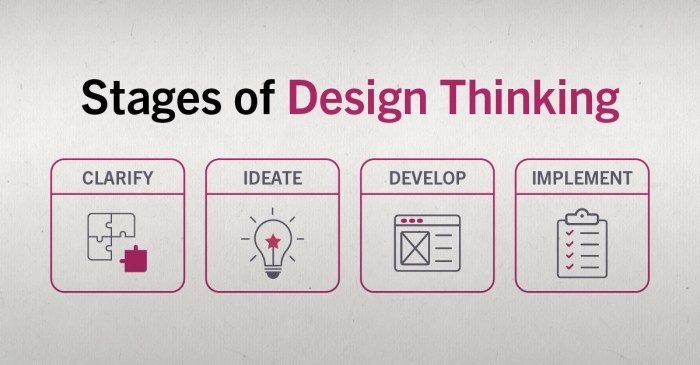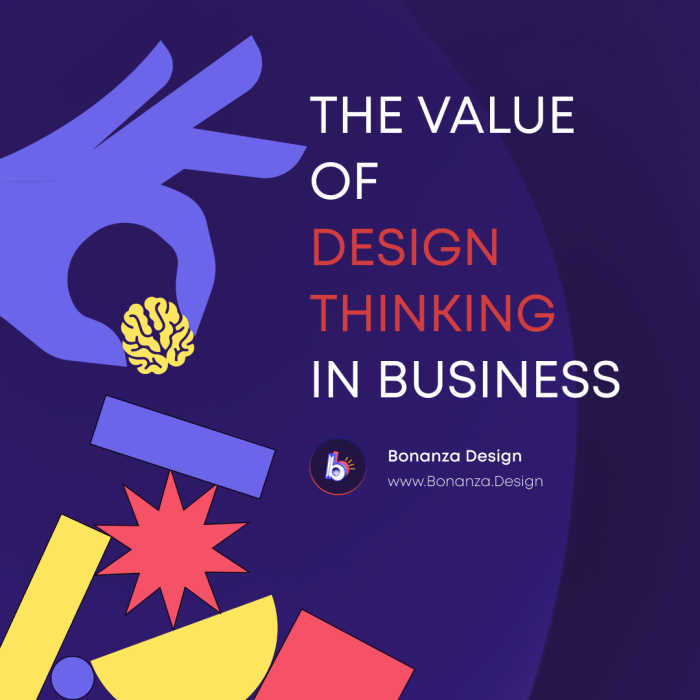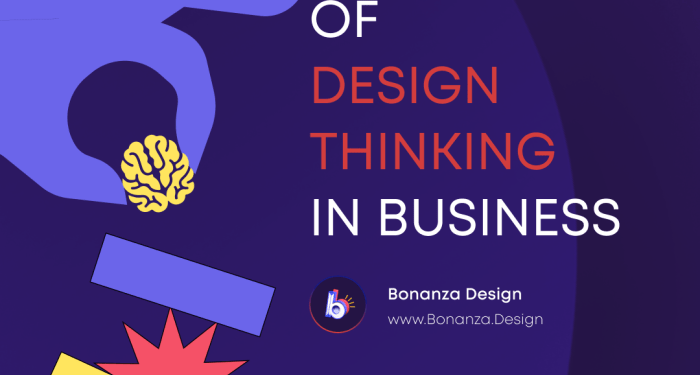Delve into the realm of design thinking in business, where creativity and innovation converge to shape the future. This captivating exploration promises to illuminate the transformative power of design thinking in driving success and growth within organizations.
In the following paragraphs, we will delve deeper into the core concepts, benefits, and practical applications of design thinking in a business context, offering valuable insights for both seasoned professionals and aspiring entrepreneurs.
Introduction to Design Thinking in Business
Design thinking is a problem-solving methodology that emphasizes empathy, ideation, prototyping, and testing in order to find innovative solutions. In the business world, design thinking has gained prominence as a way to address complex challenges and create customer-centric products and services.Unlike traditional problem-solving approaches that may rely heavily on data and analysis, design thinking puts a strong emphasis on understanding the needs and experiences of end-users.
By focusing on human-centered design, businesses can create solutions that truly resonate with their target audience.One successful example of a company that has implemented design thinking principles is Apple. From the intuitive user interface of the iPhone to the sleek design of their products, Apple's commitment to design thinking has set them apart in the competitive tech industry.
Another example is Airbnb, which used design thinking to revolutionize the way people book accommodations and travel experiences.
Benefits of Design Thinking in Business
- Enhanced customer satisfaction: By putting the customer at the center of the design process, businesses can create products and services that meet their needs and expectations.
- Increased innovation: Design thinking encourages thinking outside the box and exploring unconventional solutions, leading to breakthrough ideas and products.
- Improved collaboration: The iterative nature of design thinking promotes cross-functional collaboration and communication, fostering a culture of innovation within organizations.
- Adaptability to change: Design thinking equips businesses with the tools to quickly adapt to changing market conditions and customer preferences, staying ahead of the competition.
Benefits of Implementing Design Thinking
Design thinking offers numerous advantages for businesses looking to stay competitive and innovative in today's market. By incorporating design thinking into their strategies, companies can unlock a range of benefits that can positively impact their bottom line and overall success.
Fostering Innovation and Creativity
Design thinking encourages a creative and innovative mindset within organizations. By prioritizing empathy, collaboration, and experimentation, teams can think outside the box and come up with unique solutions to complex problems. This approach helps businesses stay ahead of the curve and adapt to changing market dynamics more effectively.
Enhancing Customer Experience and Loyalty
One of the key benefits of design thinking is its focus on understanding and meeting the needs of customers. By putting the customer at the center of the design process, businesses can create products and services that truly resonate with their target audience.
This leads to improved customer satisfaction, loyalty, and ultimately, increased profitability for the company.
Core Principles of Design Thinking
Design thinking is guided by a set of core principles that form the foundation of the process. These principles help drive innovation, foster creativity, and ensure a focus on user-centered solutions.
Empathy as a Crucial Element
Empathy is at the heart of design thinking, emphasizing the importance of understanding the needs, desires, and challenges of the end-users. By putting oneself in the shoes of the users, designers can gain valuable insights that inform the design process and lead to more meaningful solutions.
Iterative Nature and Rapid Prototyping
Design thinking is characterized by its iterative approach, where ideas are tested, refined, and improved through continuous feedback loops. Rapid prototyping allows designers to quickly create tangible representations of their concepts, enabling them to gather feedback early on and make necessary adjustments efficiently.
Applying Design Thinking in Different Business Functions

Design thinking is a versatile approach that can be applied across various business functions to drive innovation and problem-solving. By incorporating design thinking principles into product development, marketing strategies, and internal processes, businesses can enhance their overall competitiveness and customer satisfaction.
Product Development and Enhancement
- Utilize design thinking to understand customer needs and preferences, leading to the creation of products that truly resonate with the target audience.
- Iterate and prototype solutions based on user feedback, ensuring that the final product meets user expectations and delivers value.
- Encourage cross-functional collaboration to generate innovative ideas and solutions that address complex problems effectively.
Marketing and Branding Strategies
- Apply design thinking to develop compelling brand narratives that connect with consumers on an emotional level, fostering brand loyalty and advocacy.
- Use empathy and user-centricity to design marketing campaigns that resonate with target audiences and drive engagement and conversions.
- Leverage design thinking to differentiate your brand in a crowded marketplace, creating a unique and memorable brand identity that sets you apart from competitors.
Internal Processes and Culture of Innovation
- Implement design thinking in internal processes to streamline workflows, optimize resource allocation, and improve overall operational efficiency.
- Foster a culture of innovation by encouraging employees to embrace creativity, experimentation, and risk-taking in problem-solving and decision-making.
- Empower teams to challenge the status quo, think outside the box, and continuously seek opportunities for improvement and innovation within the organization.
Overcoming Challenges with Design Thinking
Implementing design thinking in a business setting can be met with various challenges, which may hinder the successful adoption and integration of this innovative approach. It is crucial for organizations to address these obstacles effectively to fully leverage the power of design thinking.
Let's explore some common challenges faced by businesses and strategies to overcome them.
Identifying Common Obstacles
- Lack of Understanding: One of the major challenges is the lack of understanding or awareness about what design thinking entails and how it can benefit the organization. This can lead to skepticism and resistance among employees.
- Resistance to Change: Implementing design thinking requires a shift in mindset and culture, which can be met with resistance from individuals comfortable with traditional methods. Overcoming this resistance is crucial for successful implementation.
- Resource Constraints: Limited resources, such as time, budget, and expertise, can pose a challenge when trying to implement design thinking initiatives. Finding creative solutions to work within these constraints is essential.
Strategies for Overcoming Resistance
- Education and Training: Providing comprehensive education and training on design thinking principles and methodologies can help employees understand the value and relevance of this approach, leading to increased buy-in.
- Engagement and Involvement: Involving employees at all levels in the design thinking process can help build ownership and commitment. Encouraging participation and feedback can foster a culture of innovation.
- Leadership Support: Strong leadership support is crucial for driving change and overcoming resistance. Leaders should champion design thinking initiatives, communicate their importance, and lead by example.
Measuring Effectiveness of Design Thinking Initiatives
- Feedback and Iteration: Gathering feedback from stakeholders throughout the design thinking process and iterating on solutions based on this feedback can help measure the effectiveness of initiatives. Continuous improvement is key.
- Impact on Business Metrics: Assessing the impact of design thinking on key business metrics, such as revenue growth, customer satisfaction, and employee engagement, can provide tangible evidence of its effectiveness in driving positive outcomes.
- Culture Shift: Observing changes in organizational culture, such as increased collaboration, creativity, and adaptability, can indicate the successful integration of design thinking into the business. Cultural transformation is a significant measure of effectiveness.
Final Wrap-Up

In conclusion, the impact of design thinking on business strategies cannot be overstated. By embracing its principles and fostering a culture of innovation, organizations can unlock new opportunities, enhance customer experiences, and stay ahead in today's dynamic market landscape. Dive into the world of design thinking and unleash its potential to propel your business towards sustainable growth and success.
Answers to Common Questions
How does design thinking differ from traditional problem-solving approaches?
Design thinking emphasizes a human-centered approach, focusing on empathy, creativity, and iterative prototyping, whereas traditional problem-solving methods often follow a linear and analytical process.
What are the advantages of incorporating design thinking in business strategies?
Design thinking can lead to enhanced innovation, improved customer experiences, and a more collaborative work culture, ultimately driving business success and growth.
How can design thinking be applied in marketing and branding strategies?
Design thinking can help businesses create more engaging and customer-centric marketing campaigns, build stronger brand identities, and differentiate themselves in competitive markets.
What are the common obstacles faced when implementing design thinking in businesses?
Resistance to change, lack of understanding or commitment from leadership, and difficulty in measuring the impact of design thinking initiatives are common challenges businesses may encounter.
How can the effectiveness of design thinking initiatives be measured in a business context?
The effectiveness of design thinking can be measured through key performance indicators related to innovation, customer satisfaction, employee engagement, and overall business growth.










